Reveal Radiant Skin: 8 Essential Acupressure Points On The Face You Need to Know
Growing up, I used to have the most adorable skin. My friends would always come to ask me the secret to my glowing skin, which usually was nothing. However, as I grew older, I realized that my skin was losing its glow. It became dry, flaky, and rough. I tried retinoid and some other glowing skin remedies I found online to no avail until a friend introduced me to the acupressure points on the face for glowing skin.
I wouldn’t try it out because I thought it was silly. Something as simple as massaging certain areas of your face shouldn’t perform the magic that lab-tested cosmetic products couldn’t perform. As a last resort, I eventually tried these acupressure points for face glow, and I didn’t regret it. The beauty of it all is that it cost nothing, and it can be done by yourself in the comfort of your home.
So, in this article, I’m going to show you the acupressure points that can remedy your dull, flaky, or dry skin as well as oily pores. Massaging these pressure points will clear blemishes from your face, restore your complexion, and bring back your youthful skin that was lost from lack of sleep, age, or stress.
What Are The Acupressure Points For Glowing Skin?
The acupressure points for glowing skin are tied to certain meridians that run through the body. Some of these meridians include the stomach, gallbladder, and liver meridian. While these meridians have pressure points on various parts of the body, the most effective pressure points for glowing skin are located on the face.
This article focuses on the acupressure points on the face for glowing skin, however. Below are these acupressure points that will restore your skin to its natural glow.
Acupoint: LI-20 (Other Names: Large Intestine-20/Ying Xiang/Welcome Fragrance)

Acupoint LI-20 is one of the acupressure points for face glow. It is called Yingxiang in Chinese, which translates to Welcome Fragrance in English. Of course, it is located on the face, making it suitable for restoring face glow. You’ll find LI-20 between each nostril, in the depression that is formed at the bottom part of the nostrils when you smile.
TCM classifies Yingxiang as the crossing point of the Liver and Stomach meridian. Therefore, this acupoint can dispel wind, clear heat, and open up blocked nasal passages. This is why LI-20 is used clinically to treat nasal congestion, itching on the face, and wry face. It is also one of the acupressure points for sleep apnea.
All you need to do to unlock the power of this acupoint is to press the acupoint with your fingertips every day for 3 to 5 minutes. Press the acupoint until both sides of your nose feel warm.
Acupoint: SI-18 (Other Names: Small Intestine-18/Quan Liao/Cheek Bone Crevice)
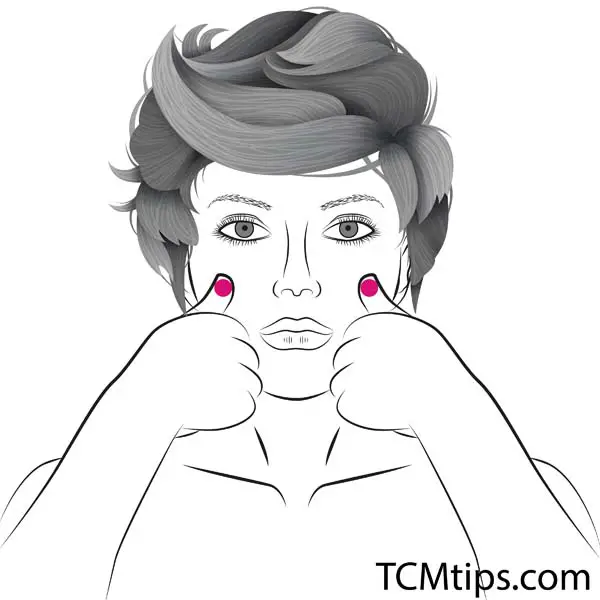
SI-18 is also called Quanliao in Chinese, and this means Cheek Bone Crevice in English. This is another acupoint to massage when you choose acupressure for glowing skin. As the name suggests, Cheek Bone Crevice is located at the edge of your cheekbone. You’ll find it in the notch directly under the corner of your eye, on the cheekbone.
In TCM, SI-18 is classified as the crossing point of both the Small Intestine and San Jiao Meridians because it expels wind and stops pain. This makes SI-18 apt for treating toothaches, wry face, facial paralysis, and any swelling on the cheek. You should also check out the top 10 acupressure points to relieve body pains & ache.
To activate this acupoint, use your fingertips to press and rub the acupoint 5 times every day. Take a pause every 15 seconds, then continue until you’ve done stimulated it 5 times for the day.
Acupoint: ST-2 (Other Names: Stomach-2/Si Bai/Four Whites)
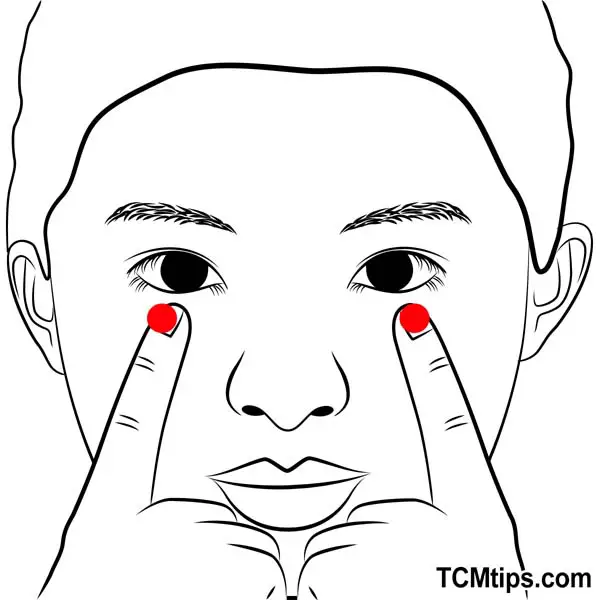
ST-2 is another of the acupressure points for face glow on the face. It is a stomach meridian acupoint that’s referred to as Sibai in Chinese or Four Whites in English. To locate this acupoint, trace a finger to the indentation on the cheek, directly below the pupil of your eyes.
ST-2 is used clinically to treat myopia, wry face, twitching eyelids, headaches, and any pain in the face, in addition to restoring skin glow. It also serves as one of the facial acupressure points for wrinkles. All you have to do is gently press and rub the acupoint with your finger for 15 seconds, 5 times a day.
Acupressure Points For Skin Whitening
If you’d like to reduce the level of melanin in your skin and get lighter, here are the acupressure points for skin whitening that you should activate.
Acupoint: GB-14 (Other Names: Gallbladder-14/Yang Bai/Yang White)
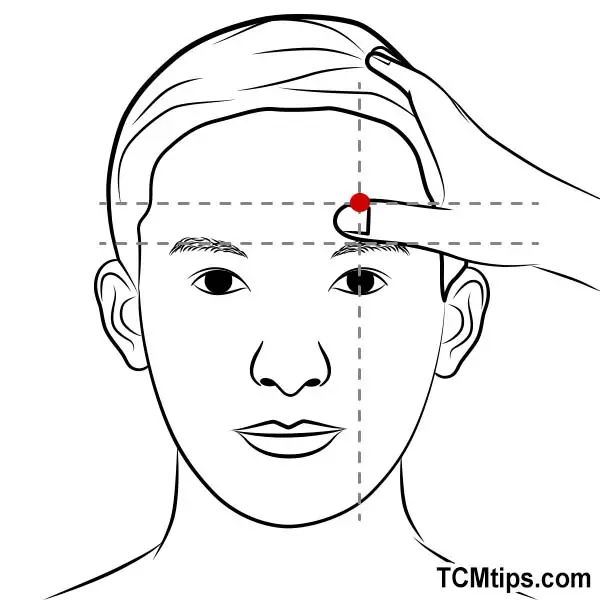
Acupoint GB-14 is a gallbladder meridian acupoint that serves as one of the acupressure points to reduce melanin. It is called Yangbai in Chinese and is located directly above the center of the eyes, one thumb away from the eyebrows.
In TCM, GB-14 functions as an improver of dullness as it promotes the flow of blood throughout the face. It is for this reason that the acupoint is used clinically to treat blurry vision, facial paralysis, vertigo, and any difficulty in closing the eyes.
To activate the skin benefits of GB-14, press the acupoint with your index or middle finger several times a day, pausing every 5 seconds. Because the skin around the eyes is thin and delicate, try not to press hard.
Acupoint: Ren-24 (Other Names: The Conception Vessel-24/Cheng Jiang/Saliva Container)
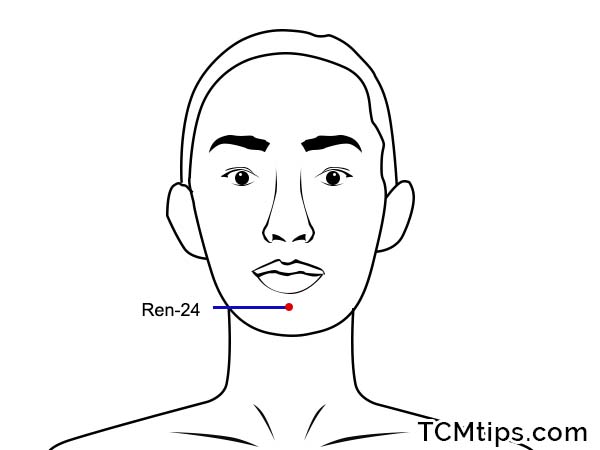
Ren-24, Chengjiang, or Container of Fluids, is another of the acupressure points for skin pigmentation that is located on the face. You’ll find this pressure point in the depression between the chin and the lower lip, at the midline below the lower lip.
TCM classifies Ren-24 as the Crossing point of the Ren Vessel and the Stomach Meridian, making it function as a wind expeller and an enhancer of blood flow. So, this acupoint, which is one of the acupoints in the face acupressure points chart, will naturally heal wry face, salivation issues, epilepsy, and enuresis.
It’s best to massage this acupoint with face cream or oil. Apply your face oil or cream in the morning and evening, then apply pressure on the acupoint with your fingers by pushing the pressure point upward in a diagonal manner. Do this for about 10 to 20 seconds, 5 times.
Acupoint: EM-5 (Other Names: Tai Yang)

Acupoint EM-5 is another of the acupressure points worthy of note for skin whitening. It is called Taiyang in Chinese, which translates to Greater Yang in English. Of course, it’s also located on the face like the others. You’ll find it in your temples. It’s the mid-point on the side of your face between the end of your eyebrow and the start of your ear.
In TCM, EM-5 functions as a clearer of heat, a dispeller of win, and a reliever of pain. So, while it is used to treat headaches, swelling of the eyes, and facial pain, it also prevents your face from wrinkling as well as the growth of dark circles and acne. EM-5 is also one of the acupressure points for headaches due to acidity.
To activate the skin benefits of EM-5, use your finger to lightly press the acupoint in a vertical motion. Do these 5 to 10 times every day, in the morning and evening, during your skincare routine.
Acupoint: ST-8 (Other Names: Stomach-8/Tou Wei/Head’s Corner)

The next acupressure point for skin whitening is the Touwei or ST-8. This is another stomach meridian acupoint that packs a lot of benefits for the skin. It is located at the corner of the forehead, at the point where the forehead meets the hairline on both sides of the head.
TCM classifies ST-8 as the crossing point of the stomach, gallbladder, and Yang Wei vessel. This classification enables ST-8 to act as a pain reliever and a dispeller of wind. TCM also believes that facial spots in women mostly occur during their “yang” period from hormonal imbalance. The Yang period is two weeks before menstruation.
ST-8 is the acupoint to massage when this occurs. All you need do to activate this acupressure for sinus infection is massage the point gently with your finger for 5 minutes at 30 seconds intervals. When you do this, you will not only be clearing spots on your face but also healing headaches, blurry vision, twitching of the eyelids, and blurry vision.
Acupoint: GV-25 (Other Names: The Governing Vessel-25/Su Liao/Plain Space)
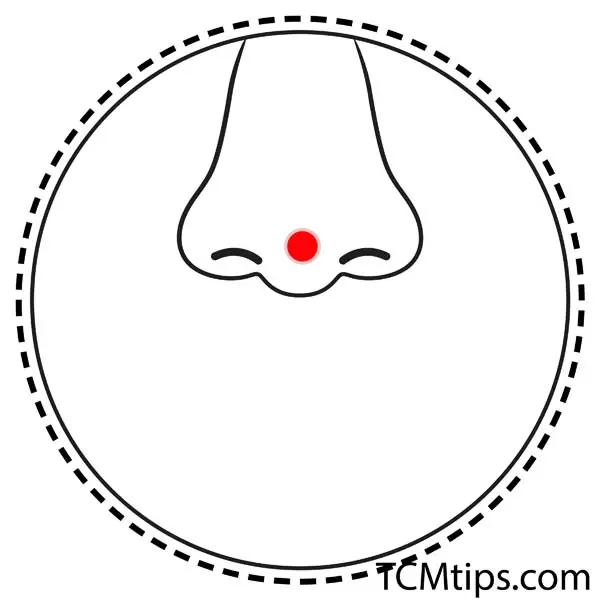
GV-25, Suliao, or White Crevice is the last acupressure point for skin pigmentation that is located on the face. This acupoint is so easy to find. It is located on the tip of the nose.
Because of its location on the nose, GV-25 packs a lot of benefits for the nose. It also serves as a vital acupressure point for resuscitation. A 2014 study supports that GV-25 is useful in regaining consciousness from coma as a result of severe craniocerebral injury. It also proves that the acupoint helps improve sneezing reflex. Together with the SP 7 acupuncture point, GV-25 can help stabilize your blood sugar.
In addition to this, GV-25 is effective in the treatment of nasal congestion, blurry vision, pain in the eyes, and, of course, the reduction of melanin. All you need do to unlock the skin benefits of GV-25 is to press the acupoint with the pad of your index finger 10 to 20 times at a 1-second interval. Do this every day, morning and evening, during your normal skincare routine.
Can Acupressure Help Skin?

Acupuncture has been around for a long time, but many think its use is for only relieving pains, nausea, and headaches. On the contrary, acupuncture and acupressure also has cosmetic benefits for your skin. They can make your skin smooth, glow, and restore your youthfulness.
Traditional Chinese Medicine (TCM) holds that stains on your skin, also known as Chloasma, have something to do with the functioning of the liver, spleen, and kidney. When there’s stagnation of your liver qi, which can be a result of troubled emotions, your skin will stain or have uneven tones.
So, it’s good to stay away from situations that will lead you to poor sleep, depression, or anger. However, if your life is face-paced and you work under pressure, you may not be able to run away from some of these emotional disturbances that cause Chloasma.
The good thing, though, is that research suggests that acupuncture combined with auricular acupressure could enhance the treatment of chloasma better than vitamin C and E. This research showed an effective rate of 95.6% for patients that received both acupuncture and auricular acupressure treatment; 91.1% for patients that received just acupuncture treatment, and; 75.6% for the control group.
Another study checked for the efficacy and safety of Facial Cosmetic Acupuncture (FCA) to facial elasticity. The result after three weeks of five treatment sessions proved that FCA aids facial elasticity by restoring resting mimetic muscle tone.

Try our Anti-Aging Gua Sha Tool designed to bring out your skin’s natural glow.
Best Gua Sha Product- Anti-Aging: The tool is designed to target 11 specific aging signs such as wrinkles and sagging skin. By following the 7-step routine, users can improve skin firmness and reduce fine lines naturally.
- Enhances Skincare Routine: It works effectively with serums and lotions, boosting absorption and efficacy of skincare products.
- Visible Skin Improvement: Users can expect a smoother complexion, reduced puffiness, and a more youthful appearance.
 P. Sze
P. Sze 

















